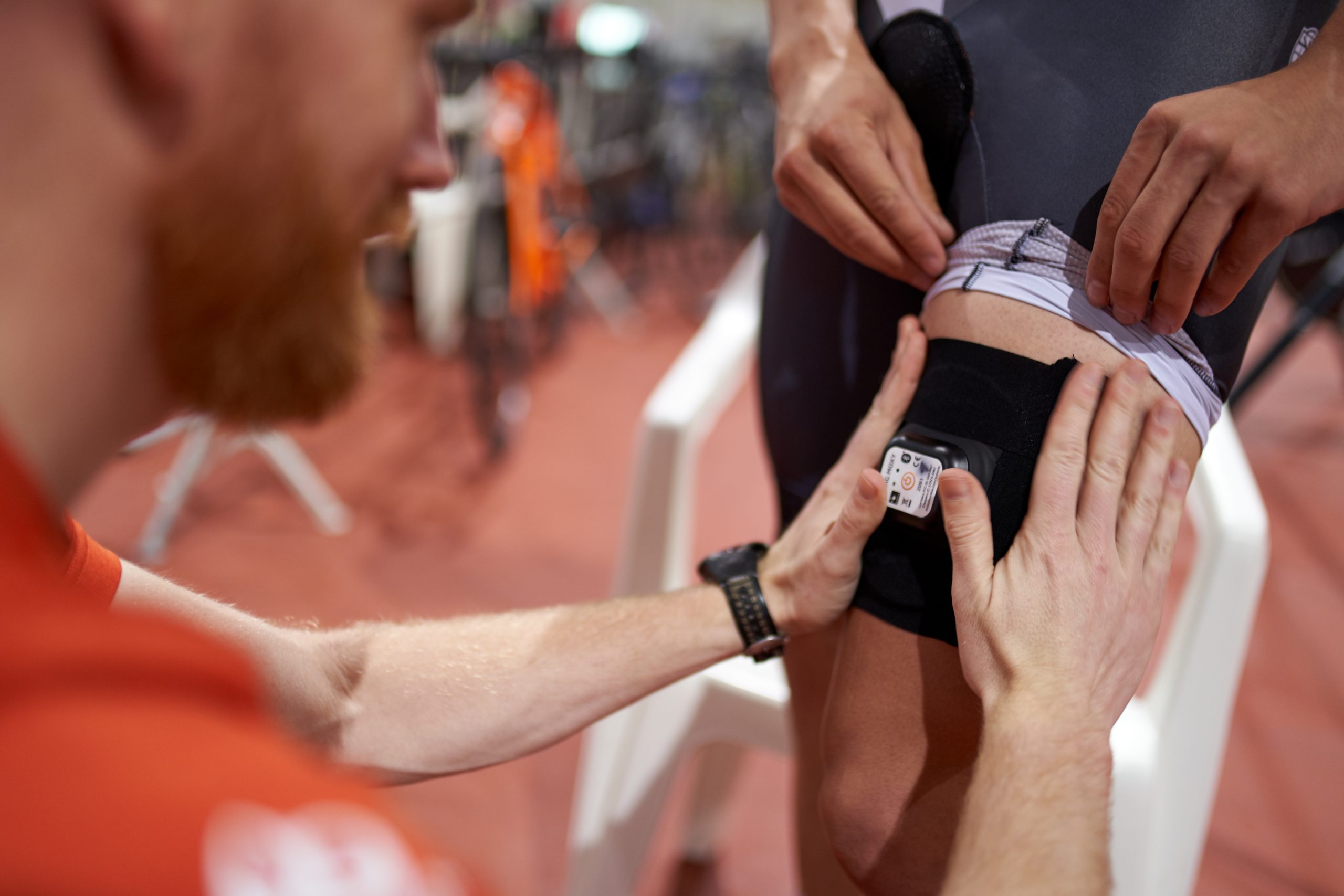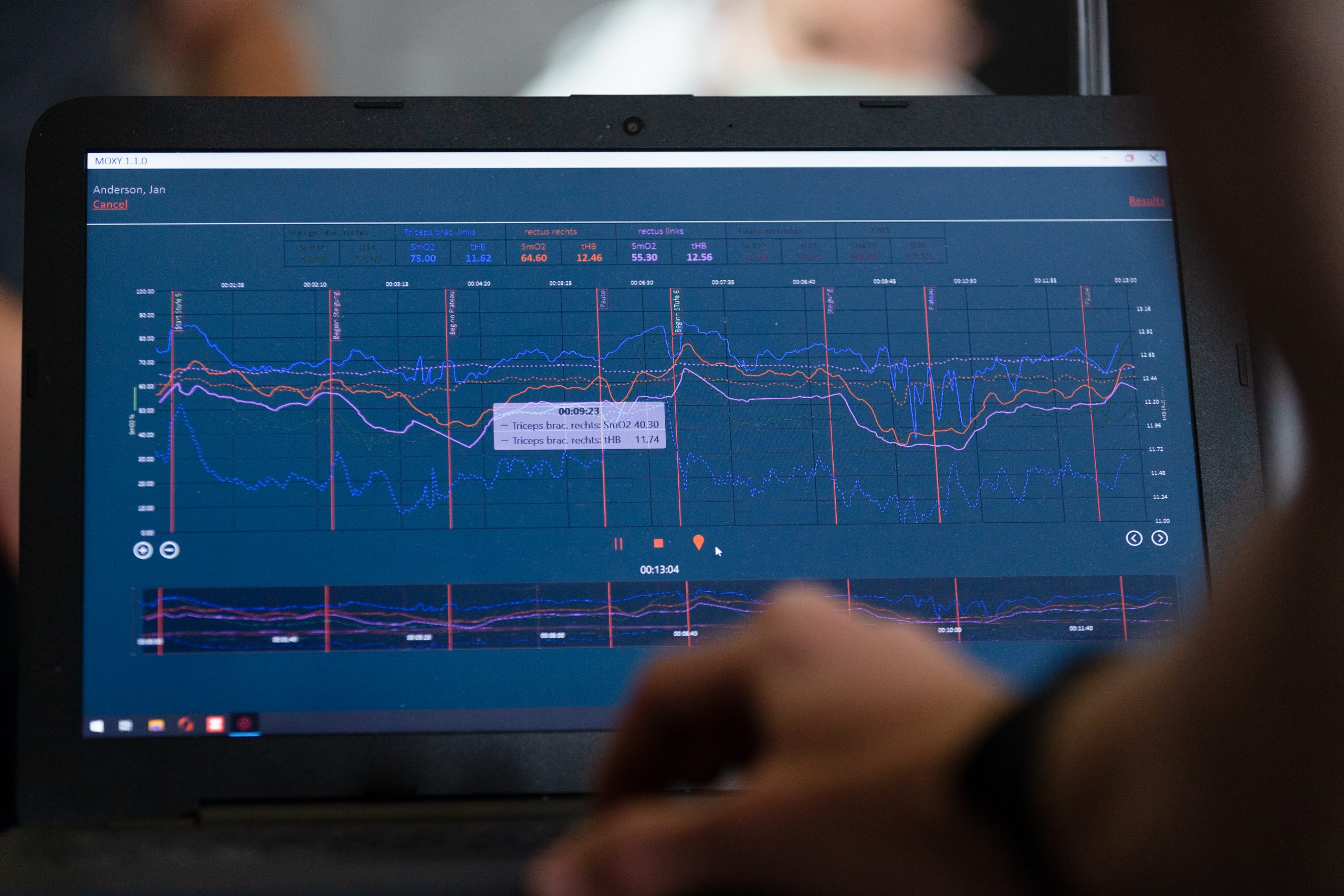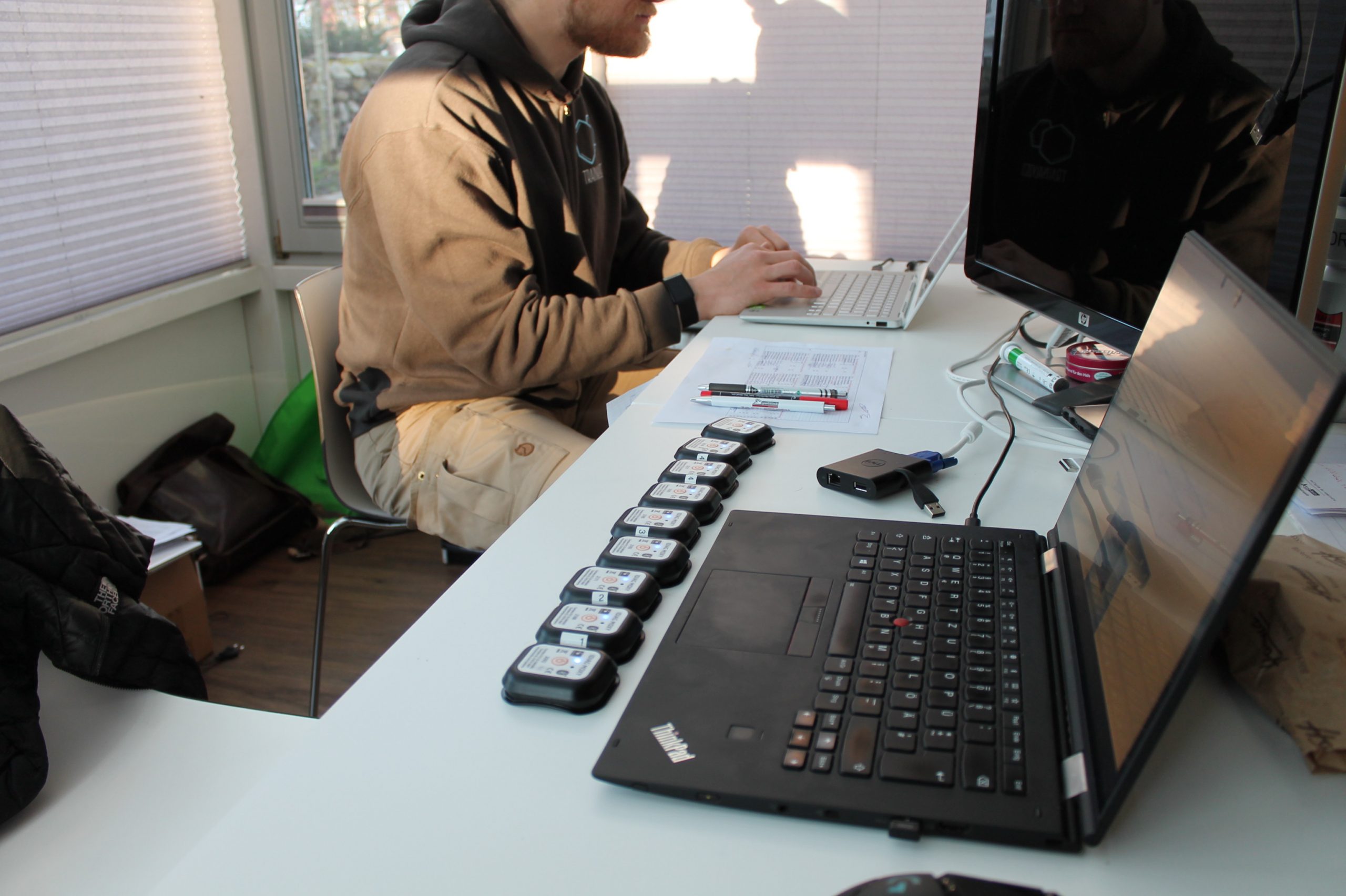Die innovative NIRS-Technologie
NIRS steht für Nahinfrarotspektroskopie und bietet eine innoviative Methode zur Leistungsdiagnostik und Trainingssteuerung. Warum?
Über die NIRS-Technologie können Leistungsstand, vorhandenes Potential, Laktatschwelle und vieles mehr sehr präzise bestimmt werden ohne dass dabei Blut abgenommen werden muss. Unser NIRS-Sensor IDIAG Moxy wird direkt am arbeitenden Muskel platziert und sendet Licht nahe dem Infrarotspektrum in das Muskelgewebe. Über 2 Empfänger wird dann die Reflexion gemessen. Die Menge des reflektierten Lichts hängt dabei vor allem von den lichtabsorbierenden Molekülen im untersuchten Gewebe ab. Im Falle des Skelettmuskels sind dies im Wesentlichen die Eisenverbindungen des Hämoglobins und Myoglobins, die in Abhängigkeit von der Verbindung mit Sauerstoff mehr oder weniger Licht reflektieren. Dementsprechend kann NIRS dazu eingesetzt werden die Konzentration und Sauerstoffsättigung des Hämoglobins und Myoglobins im untersuchten Gewebe zu messen.



Was misst NIRS?
- Sauerstoffsättigung (SmO2)
Die Sauerstoffsättigung repräsentiert die Konzentration des mit Sauerstoff besetzten Hämoglobins im untersuchten Gewebe. Sie stellt somit die Balance zwischen Sauerstoffangebot und Sauerstoffverbrauch des Skelettmuskels dar. - Totales Hämoglobin (tHb)
Veränderungen des totalen Hämoglobins repräsentieren Veränderungen des kapillaren Hämatokrits und dienen dadurch als Indikator für die lokale Durchblutung (Barstow 2019). Somit repräsentiert ein Anstieg des tHb eine gesteigerte Durchblutung und umgekehrt. Ein Abfall des tHb kann zum Beispiel durch eine geringe Trittfrequenz in Kombination mit hohem Drehmoment und die dadurch verursachte Unterbrechung des lokalen Blutflusses, ausgelöst werden. - Oxyhämoglobin (O2Hb)
Oxyhämoglobin beschreibt das mit Sauerstoff angereicherte Hämoglobin und repräsentiert das lokale Sauerstoffangebot des Skelettmuskels. Es setzt sich daher aus der aktuellen Sauerstoffsättigung und der Veränderung des totalen Hämoglobins zusammen. - Deoxyhämoglobin (HHb)
Deoxyhämoglobin ist das nicht mit Sauerstoff angereicherte Hämoglobin. Es reflektiert den metabolischen Sauerstoffbedarf des Muskels (Wang et al. 2006).
Literatur
Bellotti, Cecilia; Calabria, Elisa; Capelli, Carlo; Pogliaghi, Silvia (2013): Determination of maximal lactate steady state in healthy adults: can NIRS help? In Medicine and science in sports and exercise 45 (6), pp. 1208–1216. DOI: 10.1249/MSS.0b013e3182828ab2.
Davis, Michelle L.; Barstow, Thomas J. (2013): Estimated contribution of hemoglobin and myoglobin to near infrared spectroscopy. In Respiratory physiology & neurobiology 186 (2), pp. 180–187.
Fontana, Federico Y.; Keir, Daniel A.; Bellotti, Cecilia; Roia, Gabriela F. de; Murias, Juan M.; Pogliaghi, Silvia (2015): Determination of respiratory point compensation in healthy adults: Can non-invasive near-infrared spectroscopy help? In Journal of science and medicine in sport 18 (5), pp. 590–595. DOI: 10.1016/j.jsams.2014.07.016.
Keir, Daniel A.; Fontana, Federico Y.; Robertson, Taylor C.; Murias, Juan M.; Paterson, Donald H.; Kowalchuk, John M.; Pogliaghi, Silvia (2015): Exercise Intensity Thresholds: Identifying the Boundaries of Sustainable Performance. In Medicine and science in sports and exercise 47 (9), pp. 1932–1940. DOI: 10.1249/MSS.0000000000000613.
Mancini, D. (1997a): Application of near infrared spectroscopy to the evaluation of exercise performance and limitations in patients with heart failure. In Journal of biomedical optics 2 (1), pp. 22–30. DOI: 10.1117/12.263747.
Mancini, D. (1997b): Application of near infrared spectroscopy to the evaluation of exercise performance and limitations in patients with heart failure. In Journal of biomedical optics 2 (1), pp. 22–30. DOI: 10.1117/12.263747.
Marcinek, David J.; Amara, Catherine E.; Matz, Kimberly; Conley, Kevin E.; Schenkman, Kenneth A. (2007): Wavelength shift analysis: a simple method to determine the contribution of hemoglobin and myoglobin to in vivo optical spectra. In Applied spectroscopy 61 (6), pp. 665–669.
McCully, K. K.; Iotti, S.; Kendrick, K.; Wang, Z.; Posner, J. D.; Leigh, J.; Chance, B. (1994): Simultaneous in vivo measurements of HbO2 saturation and PCr kinetics after exercise in normal humans. In Journal of applied physiology (Bethesda, Md. : 1985) 77 (1), pp. 5–10. DOI: 10.1152/jappl.1994.77.1.5.
Nemeth, P. M.; Lowry, O. H. (1984): Myoglobin levels in individual human skeletal muscle fibers of different types. In The journal of histochemistry and cytochemistry : official journal of the Histochemistry Society 32 (11), pp. 1211–1216. DOI: 10.1177/32.11.6491255.
Ryan, Terence E.; Southern, W. Michael; Reynolds, Mary Ann; McCully, Kevin K. (2013): A cross-validation of near-infrared spectroscopy measurements of skeletal muscle oxidative capacity with phosphorus magnetic resonance spectroscopy. In Journal of applied physiology (Bethesda, Md. : 1985) 115 (12), pp. 1757–1766. DOI: 10.1152/japplphysiol.00835.2013.
van Beek-Harmsen, Brechje J.; Bekedam, Martijn A.; Feenstra, H. Maria; Visser, Frans C.; van der Laarse, Willem J. (2004): Determination of myoglobin concentration and oxidative capacity in cryostat sections of human and rat skeletal muscle fibres and rat cardiomyocytes. In Histochemistry and cell biology 121 (4), pp. 335–342.
Wang, Lixin; Yoshikawa, Takahiro; Hara, Taketaka; Nakao, Hayato; Suzuki, Takashi; Fujimoto, Shigeo (2006): Which common NIRS variable reflects muscle estimated lactate threshold most closely? In Applied physiology, nutrition, and metabolism = Physiologie appliquee, nutrition et metabolisme 31 (5), pp. 612–620. DOI: 10.1139/h06-069.
